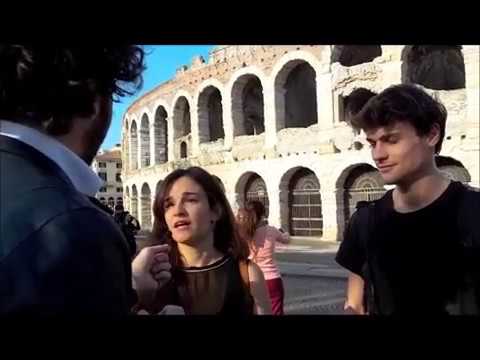What is the passato prossimo in Italian?
In Italian, the passato prossimo is a tense used to express past finished events and actions.
It is composed of the auxiliary verb “to have” or “to be“ and the past participle of the main verb.
It is not to be confused with the imperfetto; another frequently used the past tense. However, these two past tenses can be used together in the same sentence.
You can cover virtually any past situation or event with these two tenses, while you can get by without passato remoto, which is only found in novels and history books.
This post is about the passato prossimo of regular Italian verbs. There’s also a post about the passato prossimo of irregular Italian verbs.
Trivia: There’s a movie called “Passato prossimo“.
Passato prossimo: what is it for?
When studying Italian, one of the most important things to learn is how to use Italian verbs.
Let’s talk about the passato prossimo (present perfect) of Italian verbs.
First of all, in the Italian language, we do not have only one past tense, but two: passato prossimo and imperfetto.
The present perfect (passato prossimo) is used when you are referring to actions completed in the past.
Basically, it is one of the tenses that we use when we talk about actions, events, and facts that happened in the past but not long ago.
What is the passato prossimo? Let’s first look at a couple of examples of common Italian verbs:
Io ho mangiato una mela.
I’ve eaten an apple.
With this sentence, you are describing recent past events that are now completed.
All’improvviso è arrivato Marco.
Suddenly, Marco came in.
This verb tense can also be used to describe sudden actions.
By the way, remember to spell “passato prossimo” correctly: it’s not “pasato prosimo” (double the s’s!).

Passato prossimo: conjugation rules and examples
Now let’s talk about the grammar rule behind the Italian passato prossimo (past tense). How do we form it?
The passato prossimo is a compound tense (formed with 2 words).
The first one is the present tense (presente) of an auxiliary verb; the second word is the past participle (participio passato) of the verb that we are conjugating.
To create a sentence with a present perfect in it, you should follow this scheme:
SUBJECT + AUXILIARY VERB + PAST PARTICIPLE
Please note that:
In Italian, there are two different auxiliary verbs: essere (to be) and avere (to have).
Let me tell you now, most students of Italian don’t get this right, even after years of studying Italian!
Even students who consider themselves advanced—and they may well be in many areas of the language—still struggle with this concept.
Let’s look into:
- Passato prossimo: examples with the verb essere
- Passato prossimo: examples with the verb avere
Passato prossimo with essere
The verb “essere” is mostly used with verbs of motion, verbs that express a change, and the most common intransitive verbs.
Here are some examples of the Italian passato prossimo including the verb andare.
Passato prossimo: examples with essere
Verb of motion: “andare”, to go:
(Io – I) sono andato in palestra.
I went to the gym.
Verb of motion: “partire”, to leave:
(Loro – They) sono partiti ieri sera.
They left last night.
Verb of motion: “arrivare”, to arrive:
(Io, femminile – I, feminine) Sono arrivata a casa.
I arrived home.
Verb that expresses a change: “diventare”, to become:
(Tu – You) Sei diventato grande!
You’ve got big!
Verb that expresses a change: “nascere”, to be born:
(Lui – He) È nato in settembre.
He was born in September.
Verb that expresses a change: “crescere”, to grow up:
(Noi – We) Siamo cresciuti in campagna.
We grew up in the countryside.
Intransitive verb: “uscire”, to go out:
(Io – I) Sono uscito.
I went out.
Did you notice the participio passato (past participle)? When the auxiliary is “essere”, the past participle (participio passato) changes according to the number and gender of the subject. You need to conjugate it!
Now, this is actually not very hard to do and remember since you already know how Italian adjectives behave: they match the subject in gender (masculine or feminine) and number (singular or plural).
Since every past participle (including the irregular ones) ends with an –O in its base form, it’s a walk in the park to make them match the subject of the verb.
For the conjugation of the passato prossimo of essere (not as an auxiliary verb), check out our page about the irregular passato prossimo.
Italian passato prossimo with avere
The verb “avere” is used whenever verbs can be followed by an object.
These verbs are mostly transitive verbs (they are marked in every Italian dictionary with the letters “tr.”).
But there are some exceptions, and the auxiliary verb “avere” also has to be used for a few intransitive verbs.
Here are some examples of the passato prossimo with the verb avere.
Passato prossimo: examples with avere
Verb followed by an object: “mangiare”, to eat:
Io ho mangiato una pizza.
I ate a pizza.
Verb followed by an object: “sapere”, to know:
(Lei/Lui – She/He ) Ha saputo la verità.
He/she found out the truth.
Verb followed by an object: “sentire”, to hear:
(Noi – We) Abbiamo sentito un rumore.
We heard a noise.
Verb followed by an object: “capire”, to understand:
(Io – I) Ho capito.
I understood, I got it.
Intransitive verb: “camminare”, to walk:
(Loro – Them) Hanno camminato nel parco.
They walked in the park.
Intransitive verb: “viaggiare”, to travel:
(Lei/Lui – She/he) Ha viaggiato molto nella vita.
He / she travelled a lot in his / her life.
Intransitive verb: “sciare”, to ski:
(Tu – You) Hai sciato sulla montagna.
You skied on the mountain.
Intransitive verb: “nuotare”, to swim:
(Loro – Them) Hanno nuotato nel fiume.
They swam in the river.
Again, did you notice the participio passato (past participle)? When the auxiliary is “avere“, the past participle (participio passato) does not change according to number and gender, but it is invariable!
As you can see, no matter who the subject is (voi, tu, Luisa, Marco) and what the object is (questa macchina, questi libri, queste scarpe, questo libro) the past participle of the verb does not change.
For the conjugation of the passato prossimo of avere (not as an auxiliary verb), check out the page about irregular passato prossimo.
How to form the participio passato
Let’s see some rules to form the participio passato.
Usually, this is how the Italian past participle is formed:
- Verbs ending in -ARE in the infinitive tense will end in -ATO: sognare (to dream) becomes sognato (dreamt);
- Verbs ending in -ERE in the infinitive tense will end in -UTO: sapere (to know) becomes saputo (known)
- Verbs ending in -IRE in the infinitive tense will end in -ITO: sentire (to hear) becomes sentito (heard)
However, there are a lot of irregular past participles and irregular passato prossimo. The best way to recognize them is to use a dictionary and memorize them.
Sadly, the most frequent and useful have irregular past participles. There’s no way of guessing what these are, so over time, you will develop your own list.
That’s why the passato prossimo in Italian is a pain in the neck for non-native speakers!
For the conjugation of the passato prossimo of fare, check out the page about irregular passato prossimo.
Passato prossimo: test
Test your knowledge of the passato prossimo with this online Italian quiz.
It covers Lessons 31-45 of the Italian audio course “Ripeti con me!”.
At the end of the test, you’ll see the result together with a short explanation of each question.
This online grammar quiz is a chance to quickly practice the passato prossimoand other grammar patterns.
If you’re looking for exercises about the Italian past tense, you’ll also get recommendations for further practice.
Audio lessons to practice the passato prossimo
For a collection of Italian sentences to practice the passato prossimo, take lesson 31 of the Italian Audio course “Ripeti con me!”
Practice with Quizlet
Here's a set of flashcards and quizzes to practice this grammar topic.Passato prossimo: what to remember
The passato prossimo is a tense used to express past finished events and actions. It’s one of the tenses we use when we talk about actions, events, and facts that happened in the past, but not long ago.
It is not to be confused with the imperfetto, another frequently used past tense.
However, these two past tenses can be used together in the same sentence. You can cover virtually any past situation or event with these two tenses, while you can get by without passato remoto, which is only found in novels and history books.
The passato prossimo is composed of the auxiliary verb “to have” or “to be” and the past participle of the main verb.
Usually, the Italian past participle is formed as follows:
- Verbs ending in -ARE in the infinitive tense will end in -ATO: sognare (to dream) becomes sognato (dreamt);
- Verbs ending in -ERE in the infinitive tense will end in -UTO: sapere (to know) becomes saputo (known);
- Verbs ending in -IRE in the infinitive tense will end in -ITO: sentire (to hear) becomes sentito (heard).
However, there are a lot of irregular past participles and irregular passato prossimo. The best way to recognize them is to use a dictionary and memorize them.
Unfortunately, the most frequent and useful have irregular past participles.
We know it can be difficult, but don’t give up!
By familiarizing yourself with the rules of the passato prossimo, you’ll be able to use this important tense with ease.










4 Responses
E’ vero Steve, l’ho corretto. Grazie!
Error in (translation)
sognare (to dream) becomes sognato (dreamt);
verbs ending in -ERE in the infinitive tense will end in -UTO: sapere (to dream) becomes saputo (dreamt)
verbs ending in -IRE in the infinitive tense will end in -ITO: sentire (to dream) becomes sentito (dreamt)
Gracie mille! What a great explanation on how to use the past participle. I really appreciate your examples. Bravo, Stefano!
Grazie! 😀